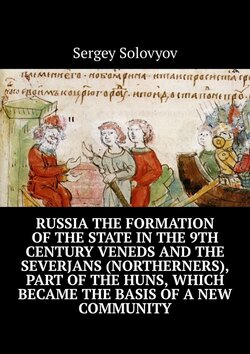Читать книгу Russia the formation of the state in the 9th century Veneds and the severjans (northerners), part of the Huns, which became the basis of a new community - Сергей Соловьёв - Страница 9
Start
ОглавлениеHow does the history of Russia relate to the history of the Huns? And Russia is directly related as a community of peoples, and as a state formation, is a continuous and direct continuation of the Hunnic community of peoples, and probably the state, because the peoples of Russia, and not only Russia, but also Europe were part of the Hunnic confederation before the Rhine. … It should be shown here that the peoples of the Baltic region lived here since ancient times, and were well acquainted with each other, which is proved by Edda, telling not only about the saints and Danes, but also about the Huns and the lands of Gardariki.
How is Gardarika translated literally? The land of kings, the land of rulers, or rather TSARGRAD, from Garda is the country, and Rika is the royal, Riksdag is literally the royal council, that is, the translation of Gardarik is the land of cities, this is an incorrect translation. Thus, Tsargrad, repeatedly named in the chronicles and writings, is Gardarika. The land was ruled by the Sirgle dynasty, according to Edda. What do the Finns call Russia now? Venaya, and Russians are called venelainen. Estonians call Russia Venemeia, and Russians call Venelainen too. The Veneds met in antiquity from Asia Minor, where they are ruled by Quintus Curtius Rufus, to Italy, the province of Venetia. In modern Germany, the Lusatian Serbs are called Sorbs or Vendians, and in official legal acts. But they are not called Slavs, that is, the term Slav itself is very late, and has a Roman origin, and was artificial. What does it mean? Obviously this is a religious symbol. Slav is a champion of the glorious, high path. And the German, the German? The word consists of two parts, here (Here. Herr) glorious, high, whence the name of souls in Wallgalle-Einheria, and hence the address in Germany – Herr or Nere in Denmark, means – Glorious. The parallels in the old Russian language are glorious, glorious, so refer to the young men and women in the Russian language That is, the words German and Slav are synonyms, and no matter how funny it is, literally Germany and Slovenia are also synonymous. Sweden is called either Schwerige or Svearike, that is, either the Kingdom of the Sveis, or the path of the Oath (swear), the name itself is terrible and demanding, and Norway is Norway (Norway) or Norge, which translates as the northern route. As proven by the cross translation, North is north, way is path. Germany in Swedish, Tuskland, and in Finnish Sachs. So the neighbors are well aware of the neighbors. The present territory of Russia was called in those distant times, according to the testimony of Saxon Grammar, Olaf Dalin, the Swedish historian of the 18th century, Venland, and before that Hunigard, that is, the country of the Huns, and the Russian North Saxon Grammaticus calls Gandwik, translated as “Bay of Gants”, then most likely, he is talking about the Gulf of Ob, the Yamal Peninsula, where, as you know, the Khanty and Mansi live, but the Danish historian calls the inhabitants of that land giants, and the stories about this northern land were full of legends and mysteries, these testimonies speak of enormous riches of these places, and that these extraordinary people also live on islands in the northern seas and that they all living in these mysterious places are sorcerers. Living folk tradition in all of Finland and some parts of Karelia ascribes to the unknown non-Finnish people who in ancient times inhabited all of Finland, the northern part of Scandinavia and even Karelia in the present territories of the Kemsky and Olonets provinces, to the still-preserved burial stone piles and mounds. The Finnish name for this ancient people is Hiishi. Saxon Grammaticus tells about one expedition of Gorm: “… Having reached Gandvik (Gulf of Ob Bay, the country of the Khanty) and having pulled the ships ashore, Gorm with his sailors camped. At dusk a man of extraordinary magnitude appeared to them, calling himself Godmund. “Travelers soon saw the settlement “looking more like a smoky cloud”. Entering one of the rooms, “they were amazed at the abundant treasures and various jewels and saw seven barrels girded with seven gold hoops and hung with silver chains of numerous rings, an extraordinary large bull’s horn, trimmed with precious stones and covered with artistic engraving, and, finally, a solid bracelet”. They were especially surprised to see “weapons designed by their size for some superhuman beings.” And the Scandinavian sailors could not resist, they did not have enough willpower and even a sense of self-preservation did not help this time, and the abundance and availability of jewelry. And the majority were very unlucky, many were “torn to pieces by monsters, and only twenty people were saved, who returned home with Gorn.” Numerous finds of archaeologists confirm the most terrible stories of Saxon Grammatik – the inhabitants of the North, the Volga and Don regions firmly believed that the dead could come to life, and in order to protect themselves, the dead were cut off feet and hands, and such manipulations are unknown anywhere else, and the sorcerers of these peoples were considered very strong in their craft. Such rites of rendering harmless the dead are not known in other states and among other tribes of Europe and Asia. And this rite appears on this territory at the beginning of the third millennium BC, in the Bronze Age. Further, Russia, in China, our Asian neighbor, is called Elos, and so many Indo-European states were called in antiquity – this is ancient Elam and the self-name of Greece – Ellas.
